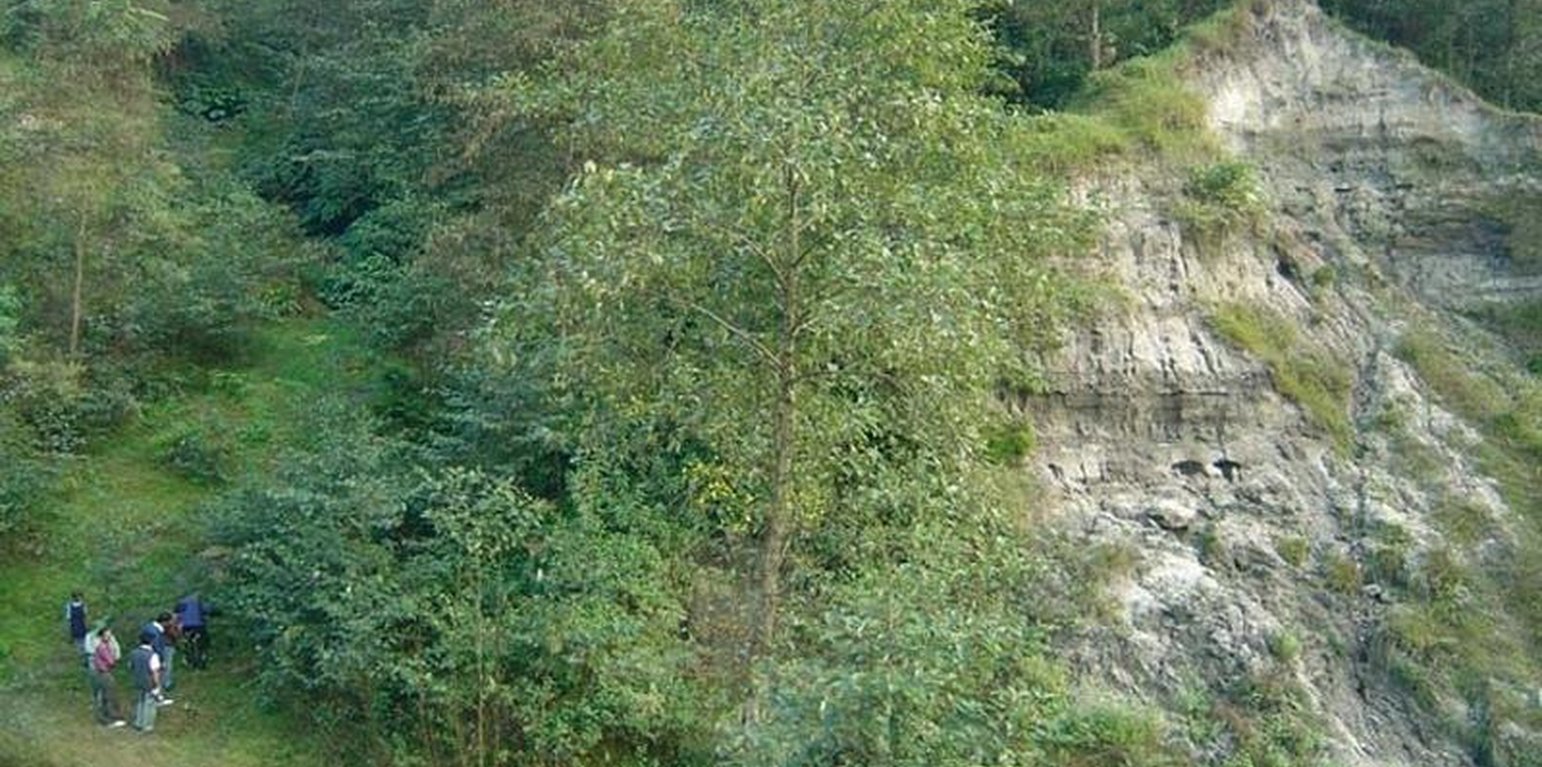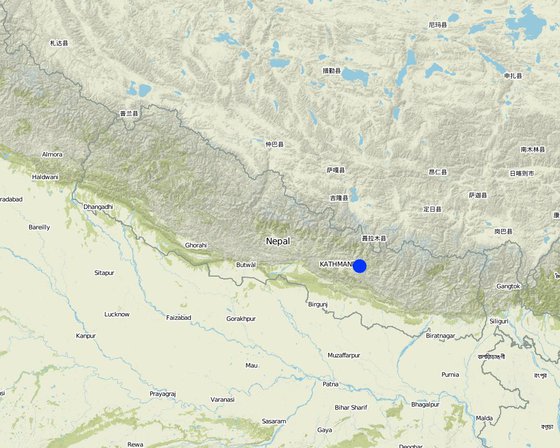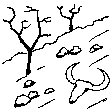



A combination of measures, implemented by a group of neighbouring families, is used to address landslips, gully formation and stream bank erosion problems in the middle hills of Nepal. All these processes affect the stability of adjacent agricultural land and cause problems downstream. Small-scale farming is dominant in the area surrounding the treated land - which theoretically belongs to the government but is used by these families.
This pilot technological package is proving suitable in Nepal for steep/very steep slopes under subhumid climates within an altitudinal range of 1,000-1,500 m a.s.l. This type of intervention, combined with the active involvement of stakeholders (who contribute three quarters of the cost), was recently introduced to Nepal under a watershed management programme, co-funded by the European Commission (see related approach ‘Integrated watershed management’).
Initially, ditches with bunds on the lower side are constructed along the contour. Within the gullies and along the stream banks, cement bags (filled with cement, brick chips, sand and/or earth) are placed to avoid deepening of the channel. Wattle fences, made from woven bamboo are also used as checks in the gullies. These structures are complemented by vegetative measures: Nepalese alder (Alnus nepalensis), bamboo (Dendrocalamus sp.), cardamom (Elettaria cardamomum), and broom grass (Thyosonaelana maxima) are planted. These species establish quickly in degraded sites and also control erosion, stabilise land and serve as cash crops, and for fodder, fuelwood and timber. Alder (locally called utis) is a nitrogen-fixing multipurpose tree which helps restore soil fertility.
Farmers can get economic benefits within a few years from these plants. Another advantage of this package is that the vegetative resources needed are locally available and cheap. Furthermore farmers already know how to propagate them. Maintenance costs are negligible. Once established, the stabilised and revegetated sites provide improved environments for birds and insects – thus favouring biodiversity - and they help protect natural springs. In this case study, the economic returns from the cash crops mainly go to one family. Another few families also utilise this site, extracting common products (fodder, litter, timber) for domestic use. Additionally, the location is regularly used as an unofficial demonstration site, being visited by various people (farmers, SWC specialists) interested in the technology. This represents an indirect benefit to a larger number of people and strengthens institutions at household and community levels.

สถานที่: Kathmandu/Bagmati watershed, Kathmandu, เนปาล
ตำนวนการวิเคราะห์เทคโนโลยี:
การเผยแพร่ของเทคโนโลยี: กระจายไปอย่างสม่ำเสมอในพื้นที่ (0.14 km²)
In a permanently protected area?:
วันที่ในการดำเนินการ: มากกว่า 50 ปี (แบบดั้งเดิม)
ประเภทของการแนะนำ







| ปัจจัยนำเข้า | หน่วย | ปริมาณ | ค่าใช้จ่ายต่อหน่วย (USD) | ค่าใช้จ่ายทั้งหมดต่อปัจจัยนำเข้า (USD) | %ของค่าใช้จ่ายที่ก่อให้เกิดขึ้นโดยผู้ใช้ที่ดิน |
| แรงงาน | |||||
| Stabilisation of gully and vegetative measures | Persons/day | 1567.0 | 1.35 | 2115.45 | 75.0 |
| อุปกรณ์ | |||||
| Tools | ha | 1.0 | 55.0 | 55.0 | 100.0 |
| Empty cement bags | pieces | 600.0 | 0.0166666 | 10.0 | |
| วัสดุด้านพืช | |||||
| Bamboo cuttings | pieces | 600.0 | 0.9416666 | 565.0 | 50.0 |
| ปุ๋ยและสารฆ่า/ยับยั้งการเจริญเติบโตของสิ่งมีชีวิต (ไบโอไซด์) | |||||
| Compost / manure | ha | 1.0 | 10.0 | 10.0 | 10.0 |
| วัสดุสำหรับก่อสร้าง | |||||
| Cement bags filled | pieces | 30.0 | 4.166666 | 125.0 | |
| Alder saplings | pieces | 2500.0 | 0.016 | 40.0 | 100.0 |
| Seedlings cardamon | pieces | 400.0 | 0.0125 | 5.0 | |
| ค่าใช้จ่ายทั้งหมดของการจัดตั้งเทคโนโลยี | 2'925.45 | ||||
| Total costs for establishment of the Technology in USD | 2'925.45 | ||||
| ปัจจัยนำเข้า | หน่วย | ปริมาณ | ค่าใช้จ่ายต่อหน่วย (USD) | ค่าใช้จ่ายทั้งหมดต่อปัจจัยนำเข้า (USD) | %ของค่าใช้จ่ายที่ก่อให้เกิดขึ้นโดยผู้ใช้ที่ดิน |
| แรงงาน | |||||
| Maintaining plants | Persons/day | 41.0 | 1.35 | 55.35 | 100.0 |
| อุปกรณ์ | |||||
| Tools | ha | 1.0 | 10.0 | 10.0 | 100.0 |
| วัสดุด้านพืช | |||||
| Compost / manure | ha | 1.0 | 5.0 | 5.0 | 100.0 |
| ค่าใช้จ่ายทั้งหมดของการบำรุงรักษาสภาพเทคโนโลยี | 70.35 | ||||
| Total costs for maintenance of the Technology in USD | 70.35 | ||||
including fuel wood
cash crop introduction
high during establishment, low during maintenance
high during establishment, low during maintenance
due to cardamom’s medicinal properties
by way of community resource mobilisation (e.g. as a result of common establishment activities; visits to the site by outsiders)
especially in case of insecure land tenureship
because of remoteness
จำนวนก่อน SLM: 80 m3/ha/y
หลังจาก SLM: 35 m3/ha/y
จำนวนก่อน SLM: 200 t/ha/y
หลังจาก SLM: 10 t/ha/yr
soil erosion increase and increased sediment transport locally during establishment of structural measures (construction of wattle fences, terraces, cement bag walls in gullies)
The agricultural land which is located on the upper portion of the SWC area is stabilised
grazing pressure will increase on another site because of the SWC site is closed for grazing